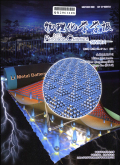长期探寻的Au23(S-Adm)16结构及未曾预期的掺杂效应
Long-Pursued Structure of Au23(S-Adm)16 and the Unexpected Doping Effects
摘要
Abstract
Metal nanoclusters are rising stars in material science,and one advantage is their atomically precise tunability.It is well known that metal doping can efficiently modify the properties of metal nanoclusters.In particular,without altering the parent nanocluster framework,doping a single heterometal atom can tailor the properties of metal nanoclusters and aid investigations of the structure-property relationship of metal nanoclusters.To our knowledge,the simultaneous synthesis of a single heterometal-doped nanocluster and its parent nanocluster is challenging and has not been previously reported;however,this is highly desirable because it can prevent the influence of trace impurities and allow comparison between doped and undoped nanoclusters.The single Cd-doped gold nanocluster Au22Cd1(S-Adm)16(S-Adm=1-adamantanethiolate)has been previously synthesized and structurally elucidated.However,the structure of the parent nanocluster,Au23(S-Adm)16,remains unknown,inspiring this investigation.In this study,we synthesized Au23(S-Adm)16 and its single-doped Au22Cd1(S-Adm)16 nanocluster in one pot for the first time,and we resolved their structures using single-crystal X-ray crystallography.The structure of Au22Cd1(S-Adm)16 is similar to that of Au23(S-Adm)16 except that a kernel Au atom in Au23(S-Adm)16 is replaced with a Cd atom.This Cd replacement causes the kernel Au—Au bond length to increase owing to the loosening of the original closely packed structure.In contrast to prior reports,Au23(S-Adm)16 is surprisingly more stable than Au22Cd1(S-Adm)16,as determined via ultraviolet visible-near infrared(UV-Vis-NIR)spectroscopy at 80 ℃.This stability was attributed to the decrease in the kernel Au—Au bond length.Although the maximum absorption of Au22Cd1(S-Adm)16 slightly red-shifted from 605 to 608 nm after Cd doping,the molar extinction coefficient of Au23(S-Adm)16 at 605 nm was approximately twice that of Au22Cd1(S-Adm)16 at 608 nm.Thus,the increase in kernel Au—Au bond length may decrease the photoexcitation electron transfer efficiency owing to lengthening of the photoexcitation electron transfer pathway.As further support for this opinion,although the two nanoclusters showed similar emission profiles and maxima(750 nm for Au23(S-Adm)16 and 760 nm for Au22Cd1(S-Adm)16),they exhibited obvious emission intensity differences.Specifically,the quantum yield of Au23(S-Adm)16(approximately 3.160×10-5)was found to be 1.13 times that of Au22Cd1(S-Adm)16(approximately 2.793×10-5).Thus,the stability and absorption and emission intensities correlate with the kernel Au—Au bond length. This study shows that two metal nanoclusters with slight structural differences can exhibit different properties in terms of optical and thermal stability,providing a good reference for studying their structure-property relationships.关键词
金属纳米团簇/合成/Au—Au键长/性质/构效关系Key words
Metal nanoclusters/Synthesis/Au—Au bond length/Property/Property-structure correlation分类
化学引用本文复制引用
冯磊,朱泽敏,杨颖,何宗兵,邹家丰,李漫波,赵燕,伍志鲲..长期探寻的Au23(S-Adm)16结构及未曾预期的掺杂效应[J].物理化学学报,2024,40(5):1-3,3.基金项目
The project was supported by the National Natural Science Foundation of China(21925303,21771186,21829501,21222301,21528303,21171170,92061110),CASHIPS Director's Fund(BJPY2019A02),Key Program of 13th Five-year Plan,CASHIPS(KP-2017-16),Collaborative Innovation Program of Hefei Science Center,CAS(2020HSC-CIP005,2022HSC-CIP018),Anhui Provincial Natural Science Foundation(2108085Y05),Hefei National Laboratory for Physical Sciences at the Microscale(KF2020102),and the Startup Fund of Anhui University(S020318006/037). 国家自然科学基金(21925303,21771186,21829501,21222301,21528303,21171170,92061110),中国科学院合肥研究院院长基金(BJPY2019A02),中国科学院合肥研究院十三五重点计划(KP-2017-16),中国科学院合肥科学中心协同创新项目(2020HSC-CIP005,2022HSC-CIP018),安徽省自然科学基金(2108085Y05),合肥微尺度物理科学国家实验室(KF2020102)及安徽大学启动经费(S020318006/037)资助 (21925303,21771186,21829501,21222301,21528303,21171170,92061110)

